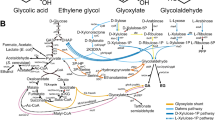Abstract
The study demonstrates that Saccharomyces cerevisiae VKPM Y-1693 yeast is resistant to the aqueous enzymatic Miscanthus hydrolysate. The good morphophysiological condition of the yeast indicates that the media contain no detrimental impurities characteristic of acidic chemical hydrolysates. It is shown that the native active acidity of the hydrolysate (pH 4.5–4.7) is optimal for ethanol biosynthesis from enzymatic Miscanthus cellulose hydrolysate. An addition of 1% yeast extract makes the aqueous enzymatic Miscanthus cellulose hydrolysate medium complete. Under the conditions of batch fermentation, it is sufficient to introduce 10% yeast inoculum in the log phase of growth. As shown by gas-liquid chromatography, the enzymatic digestion of Miscanthus cellulose produces ethanol with low contents of esters and fusel oils. Miscanthus bioethanol the contains no methanol.
Similar content being viewed by others
References
Ablaev, A.R., Big oil and biofuels, Biotekhnologiya, 2011, no. 3, pp. 8–14.
Ageev, L.M. and Korol’kov, S.I., Khimiko-tekhnicheskii kontrol’ i uchet gidroliznogo i sul’fitno-spirtovogo proizvodstva (Chemical and Technical Control and Accounting of Hydrolytic and Sulfite-Alcohol Production), Moscow: Goslesbumizdat, 1953.
Brosse, N., Sannigrahi, P., and Ragauskas, A., Pretreatment of Miscanthus giganteus using the ethanol organosolv process for ethanol production, Ind. Eng. Chem. Res., 2009, vol. 48, pp. 8328–8334.
Budaeva, V.V., Gismatulina, Yu.A., Zolotukhin, V.N., Sakovich, G.V., Veprev, S.G., and Shumnyi, V.K., Indicators of quality of pulp produced by the nitrate method in laboratory and experimental-industrial conditions from Miscanthus, Polzunov. Vestnik, 2013, no. 3, pp. 162–168.
Bulatkin, G.A. and Mitenko, G.V., Promising energy culture—Chinese Miscanthus, Ekol. Vestn. Rossii, 2013, no. 7, pp. 31–36.
Gismatulina, Yu.A. and Budaeva, V.V., Chemical composition of the Russian Miscanthus and the quality of pulp produced from it, Khim. Interesah Ustoich. Razvit., 2013, vol. 21, no. 5, pp. 539–544.
GOST 17299-78. Spirt etilovyi tekhnicheskii. Tekhnicheskie usloviya (GOST 17299-78. Technical Ethyl Alcohol. Technical Conditions), Moscow: Izd. Standartov, 1978.
GOST R 51135-98-2003. Izdeliya likerovodochnye. Pravila priemki i metody analiza. Tekhnicheskie trebovaniya. Vved. 1998-03-02 (GOST R 51135-98-2003. Alcoholic Products. Acceptance Rules and Methods of Analysis. Technical Requirements. Introduced March 2, 1998), Moscow: IUS, 2003.
GOST R 51786-2001. Vodka i spirt etilovyi iz pishchevogo syr’ya. Gazokhromatograficheskii metod opredeleniya podlinnosti (Vodka and Ethyl Alcohol from Food Raw Materials. Gas Chromatographic Method for Determination of Authenticity), Moscow: Izd. Standartov, 2001.
GOST R 52193-98-2003. Spirt etilovyi-syrets iz pishchevogo syr’ya. Tekhnicheskie usloviya (Ethyl Alcohol from Food Raw Materials. Technical Conditions), Moscow: Izd. Standartov, 2005.
Jordan, D.B., Bowman, M.J., Braker, J.D., Dien, B.S., Hector, R.E., Lee, C.C., Mertens, J.A., and Wagschal, K., Plant cell walls to ethanol, Biochem. J., 2012, no. 442, pp. 241–252.
Kuznetsova, O.Yu., Modern aspects of bionano- and/or nanobiotechnology, Vestn. Kazan. Tekhnol. Univ., 2013, vol. 16, no. 3, pp. 156–163.
Pavlov, I.N., Appliance for studying the biocatalytic conversion of raw materials other than wood processing products, Kataliz Promyshl., 2014, no. 1, pp. 66–72.
Sharkov, V.I., Sapotnitskii, S.A., and Dmitrieva, O.A., Tekhnologiya gidroliznykh proizvodstv (Technology of Hydrolysis Industries), Moscow: Lesn. Prom., 1973.
Shumnyi, V.K., Kolchanov, N.A., Sakovich, G.V., Parmon, V.N., Veprev, S.G., Nechiporenko, N.N., Goryachkovskaya, T.N., Bryanskaya, A.V., Budaeva, V.V., Zheleznov, A.V., Zheleznova, N.B., Zolotukhin, V.N., Mitrofanov, R.Yu., Rozanov, A.S., Sorokina, K.N., Slyn’ko, N.M., Yakovlev, V.A., and Pel’tek, S.E., Search for renewable sources of pulp for multipurpose use, Vavilov Zh. Genet. Selekts., 2010, vol. 14, no. 3, pp. 569–578.
Skiba, E.A., Budaeva, V.V., Pavlov, I.N., Makarova, E.I., Zolotukhin, V.N., and Sakovich, G.V., Obtaining enzymatic hydrolysates of technical pulps of Miscanthus and their alcoholic fermentation, Biotekhnologiya, 2012, no. 6, pp. 42–52.
Somerville, C., Youngs, H., Taylor, C., Davis, S.C., and Long, S.P., Feedstocks for lignocellulosic biofuels, Science, 2010, vol. 329, pp. 790–792.
Yarovenko, V.L., Marinchenko, V.A., and Smirnov, V.A., Tekhnologiya spirta (Technology of Alcohol), Moscow: Kolos, 1999.
Author information
Authors and Affiliations
Corresponding author
Additional information
Original Russian Text © O.V. Baibakova, E.A. Skiba, 2014, published in Vavilovskii Zhurnal Genetiki i Selektsii, 2014, Vol. 18, No. 3, pp. 564–571.
Rights and permissions
About this article
Cite this article
Baibakova, O.V., Skiba, E.A. Biotechnological aspects of ethanol biosynthesis from Miscanthus . Russ J Genet Appl Res 5, 69–74 (2015). https://doi.org/10.1134/S2079059715010025
Received:
Accepted:
Published:
Issue Date:
DOI: https://doi.org/10.1134/S2079059715010025




